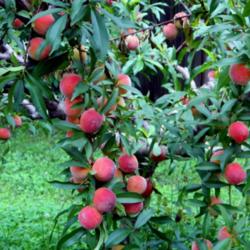
Few gastronomical treats come close to the season's first bite into a peach: the faint tingle of fuzz on your lips, the flesh, softer and sweeter than you remembered, and the trickle of juice down your chin, warm, sticky, and wonderful. As with most fruit trees, the trick is to start out with the peach variety that suits your climate. Peaches will grow in USDA zones 4 to 8; they do especially well in zones 6 and 7. Since most peach varieties are self-fertile, you can plant just one tree at a time ('J. H. Hale' and 'Elberta' are among the exceptions). Peaches ripen from mid-July through mid-September. If you are planting more than one tree, be sure to select varieties with different ripening periods to extend the harvest.
Choosing VarietiesPeaches have very specific needs for dormancy, and at certain times, can be extremely susceptible to frost damage. It's important to choose the correct variety and rootstock for your area. In order to break dormancy and begin flowering, peach trees require a certain number of chilling hours below 45° F during the winter; most need between 65° and 95° F. If you choose a variety that needs fewer hours of chilling than your area provides, your peach tree could start to bloom during a January or February thaw. A cold snap could then spoil your whole crop of blossoms. Or, if you pick a variety that needs more chilling hours than your area provides, dormancy will never be broken properly, blossoms might appear one month on one branch, one month on another, shoots will be bare, and your crop poor.
Cold and PeachesSome varieties are more cold tolerant than others. Most peach trees will not blossom and often cannot survive temperatures below -10° F. A few varieties such as 'Reliance', 'China Pearl', and 'Intrepid' tolerate temperatures as low as -20° F. Peach trees are also susceptible to frost damage right near the end of dormancy. A cold snap in early spring can damage the flower buds on a tree with little spring frost resistance. Trees in areas with cold winters tend to develop buds slowly and bloom late enough so they're not bothered by spring frosts. But trees in areas with mild winters develop buds rapidly and are vulnerable to early spring frost. If you live in a good peach-growing area (zones 5 to 8, and especially zones 6 and 7), you can worry less about cold resistance and focus instead on flavor when choosing a variety.
Best VarietiesMany growers rate midseason peaches as the best in flavor. Of those, some favorites are 'Red Globe', 'Loring', 'Suncrest', 'Madison', 'J. H. Hale', 'Jefferson', and 'Jerseyqueen'. Others claim that white peaches such as 'Nectar' and 'Belle of Georgia' are the gourmet's choice. Traditionalists swear by such old varieties as 'Late Crawford'.
For canning, both cling and freestone have their advantages and drawbacks. Cling peaches have a firm flesh that doesn't bruise easily with handling. Freestones have softer flesh and easy-to-remove pits. You can also grow nectarines, a genetic variation of peaches that produces fuzzless fruit. Nectarines are grown the same way as peaches, but they are more susceptible to brown rot.
Photo by Jack Dykinga/USDA Agricultural Research Service
 Victory Seed Company has all the seeds you want for your best garden in 2024.
Victory Seed Company has all the seeds you want for your best garden in 2024.
For 25 years, the family-owned Victory Seed Company has provided the highest quality vegetable, herb and flower seeds to families across the country. We are passionate about providing you the best seeds available that give excellent germination, robust plants, and the harvest you want. With a catalog of over a thousand varieties, we have everything, and our prices are the kinds that we'd want to pay. We have hundreds of yesterday's heirloom vegetables, as well as today's award winning hybrid selections. Get to know us by visiting our website and browsing through our online vegetable seed catalog.
| 1. Peach Essentials |
| 2. Planning for Peaches ← you're on this article right now |
| 3. Peach Care |
| 1. Peach Essentials |
| 2. Planning for Peaches ← you're on this article right now |
| 3. Peach Care |